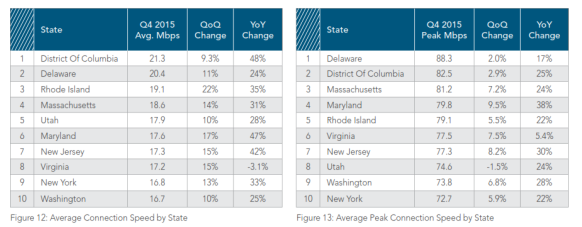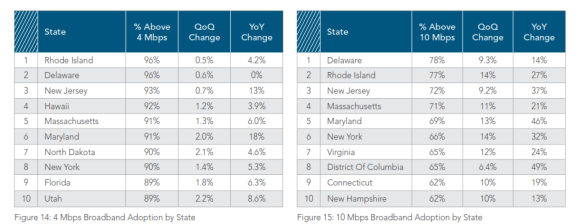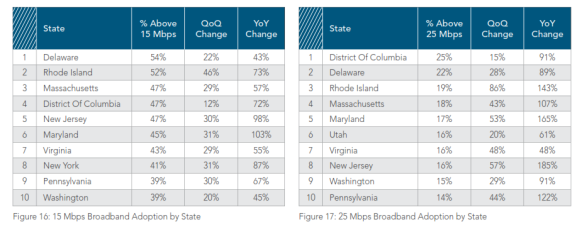The latest Akamai State of the Internet is out (Q4 2015). For eight years Akamai has been tracking the national and international status of broadband. The report is a great overview of what’s happening around the world.
It’s also a good look at how Minnesota stacks up to the rest of the world. Let’s start by saying – we don’t. The report itself only lists “top ten” contenders in any category and Minnesota doesn’t make the top ten. Not once. But the good folks at Akamai have been kind enough to send me our ranking, speeds and details.
Minnesota Legislators are talking now about speed goals to take Minnesota into 2022. The former speed goals were also tied to how Minnesota compared nationally and globally. It might make sense to look at that again – or I don’t think well be ranking any higher in 2022 than we are now. (I haven’t added the international comparison but it’s even worse.)
Here’s how we rank…
Average and Peak Connection Speed
- Average Speed: Minnesota ranks #18 with an average speed of 14.9 Mbps
- Peak Speed: Minnesota ranks #23 with a peak speed of 61.8 Mbps
Those numbers compare with the following:
Broadband adoption at 4 Mbps (and faster) and 10 Mbps (and faster)
- 4 Mbps adoption: Minnesota is #29 with 84 percent adoption
- 10 Mbps adoption: Minnesota is #26 with 51 percent adoption
Those numbers compare with the following:
Broadband adoption at 15 Mbps (and faster) and 25 Mbps (and faster)
- 15 Mbps adoption: #22 with 33 percent adoption
- 25 Mbps adoption: #16 with 12 percent adoption
Those numbers compare with the following:
And info on how the info is tracked…
Through its globally deployed Intelligent Platform, and by virtue of the more than 2 trillion requests for web content that it serves on a daily basis, Akamai has unique visibility into levels of Internet penetration around the world. In the fourth quarter of 2015, over 810 million unique IPv4 addresses from 243 unique countries/regions connected to the Akamai Intelligent Platform. This is a 0.9% increase in the number of unique IPv4 addresses seen by Akamai as compared with the fourth quarter of 2014 and a 0.2% increase from the number seen in the third quarter of 2015.
And why they selected those speeds to track…
The data presented within this section was collected during the fourth quarter of 2015 through Akamai’s globally deployed Intelligent Platform and includes all countries/regions that had more than 25,000 unique IPv4 addresses request content from Akamai during the quarter. Prior to 2015, State of the Internet reports looked at connection speeds of these requests within three different threshold classifications — namely 4 Mbps (“broadband”), 10 Mbps (“high broadband”), and 15 Mbps (“4k ready”). However, in its 2015 Broadband Progress Report, the U.S. Federal Communications Commission (fcc) increased its benchmark definition of broadband Internet service to download speeds of 25 Mbps, sharply raising the bar from the 4 Mbps definition it had set in 2010.
Given this new standard, beginning with the First Quarter, 2015 State of the Internet Report, Akamai began
tracking data for the 25 Mbps threshold (in addition to the three preexisting thresholds) in both the global and United States data sets.




I already left a message regarding Minnesota’s poor results on broadband service. When I left Wisconsin one year ago, I had finally gotten up to 10 Mbps. Now I’m getting 1.47 Mbps, and taken a step back in technology.
One year later, my Wisconsin neighbor, who lived next door, is getting 50 Mbps. If we can get atleast 10 Mbps here, it would be so wonderful. Higher numbers would be bragging rights.
I can only imagine how frustrating that must be! There are definitely areas in Minnesota where we need to see some serious upgrades.